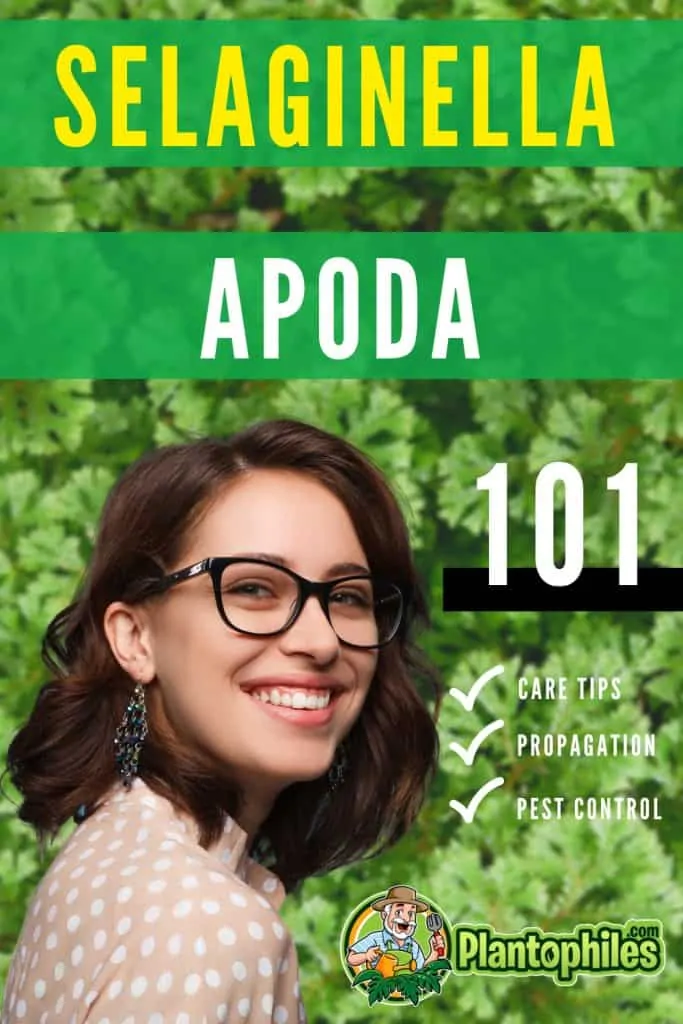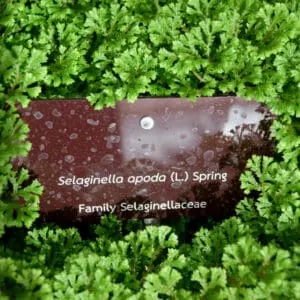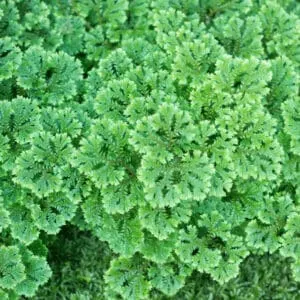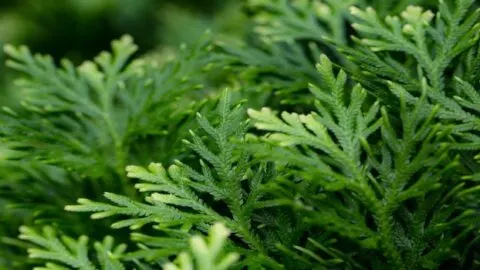Today, we will have a look at the Selaginella apoda care.
The genus Selaginella contains about 700-800 different species.
However, it needs to be pointed out that only a few of them are actually cultivated as houseplants.
Selaginella apoda, which also goes by the name of Meadow Spike Moss, is certainly one of them.
The habitat of Selaginella apoda is fields and meadows as well as man-made habitats (anthropogenic), shores of rivers and lakes according to Go Botany Native Trust.
Selaginella care is not easy, as these plants have very specific needs, especially with regards to the right temperature and appropriate humidity.
As always, I will start with our plant care guide, giving you the most important care tips for Selaginalle apoda upfront.
Selaginella apoda Care
To care for Selaginella apoda you can use regular potting soil. Provide a semi-shaded spot in terms of lighting. Keep the soil moist but not soggy. To water use rain or distilled water at room temperature. Keep the temperature around 55 to 64 °F (13 to 18 degrees °C). Provide humidity between 60-80%. Fertilize once with a regular houseplant fertilizer at half-strength after one year of buying the plant.

Selaginella apoda Care
Table of Contents
Selaginella Apoda Care Basics
Soil
Selaginella has no special demands in regard to plant soil.
Simply use a regular potting soil mix.
Quality soil for potted plants has all the important properties to ensure the healthy growth of Selaginella.
Loose, medium-coarse soil with sufficient nutrients produces the best results.
The PH value for the soil should be between 5 to 6 for Selaginella apoda.
To determine the PH value of the soil, it is usually sufficient to take a look at the packaging, as this value is always indicated there.
However, if you have mixed the compost yourself and cannot simply read the PH value on the packaging, you can buy a soil meter to easily determine the PH value.
Soil meters often offer 3-in-1 functionality and let you measure the ph value as well as soil moisture and sunlight intensity.
Light
Depending on the type of Selaginella, the required lighting conditions can vary greatly.
When trying to mimic the natural habitat of Selaginella apoda, the right amount of lighting will be key to healthy growth for your leafy friend.
As far as Meadow Spike Moss is concerned, if cultivated indoors, it is best if it is in a semi-shady location.
Direct sunlight is not well tolerated by Selaginella apoda.

Multiple Selaginella apoda
Watering
As with many other houseplants, keep the compost moist, but not soggy. Never let the soil dry up completely.
As always, don’t use cold water (water should be at room temperature) for watering and preferably use soft water rather than hard water.
Rainwater and distilled water are fine, too.
Use lime-free water whenever possible.
Temperature
The ideal temperature for Selaginella apoda is around 55 to 64 °F (13 to 18 degrees °C).
As far as the right temperature is concerned, Selaginella apoda is not very delicate. It tolerates average room temperatures as well as colder temperatures.
But the plant tolerates warmer temperatures quite well.
Humidity
Selaginella plants demand high humidity. This is also the reason why these plants thrive extraordinarily well in glass pots.
The high humidity is the most important factor for Selaginella. If it cannot be guaranteed, then your Selaginella apoda is almost certainly doomed to failure.
The relative humidity for Selaginella should be at least about 60%. But values around 80 percent are better.
See below for tips on how to provide humidity for your Selaginella plant.
Fertilizer
Feeding Selaginella is usually only required one year after purchase or one year after repotting.
Regarding the choice of plant fertilizer, you can use conventional plant fertilizer.
As far as the dosage is concerned, however, you should only use half of the amount indicated on the packaging.
However, it must be said at this point that in many cases fertilization is not even an issue for Selaginella, as these plants are often short-lived as houseplants.
If you are looking for houseplants that you can keep for a long time without any problems, then Pothos or ZZ plants might be just what you are looking for.
These two plants are extremely easy to care for and can be kept for several years with the right care.
Selaginella is not exactly easy to care for but let’s leave it at that for the moment.

Selaginella apoda belong to the Selaginellaceae family
Propagation
Selaginella can be propagated by cuttings. Propagation in itself is not difficult, but the problem is that selaginella plants do not survive long as houseplants. So if you want to propagate selaginella, it is better not to wait too long!
Selaginella can also be propagated through division.
For both methods of propagation, i.e. by cuttings or by division, spring is the most suitable time period.
Growth
In fact, Selaginella is a slow-growing plant.
Like many other species of Selaginella, Meadow Spike Moss makes a good groundcover, for example in a terrarium or in a bottle garden or even as woodland groundcover. It rarely gets over 2 inches tall.
(Re)potting
Repotting Selaginella should generally not be a headache for you, for the simple reason that with Selaginella it usually doesn’t even happen, as Selaginella, in most cases, only survives for a short time as a houseplant.

Selaginella apoda in cultivation
High humidity is key for Selaginella apoda
As we have already seen, high humidity is essential when it comes to the care of Selaginella.
So how can you guarantee the high humidity on which Selaginella depends so much?
There are some things you can do without much effort to create a high humidity environment for Selaginella.
First, you should mist Selaginella apoda daily. Maybe better twice a day, if you have the time. First, you should mist Selaginella apoda daily. Maybe better twice a day, if you have the time.
You can simply use a traditional hand mister and then spray the leaves with it.
Secondly, you should place the plant in a room with high humidity. Ideal in most cases is the kitchen or, even better, the bathroom.
Selaginella indeed makes a great bathroom plant, as do Lucky Bamboo, Aloe Vera, Croton, Dumb Cane, Peace Lily and several other houseplants.
Take a look at our article “The 12 Best Houseplants for your Bathroom” to find out which other houseplants are suitable for cultivation in the bathroom.
Another thing you can do to ensure high humidity levels for your Selaginella apoda is to keep it on a bed of damp pebbles.
Selaginella Apoda Display Tips
Selaginella is particularly well suited as an underplanting. The cultivation in a glass bottle (bottle garden) is highly recommended.
On the one hand, Selaginella looks beautiful in such containers, and on the other hand there is a particularly high air humidity in these bottle gardens, which is indispensable for Selaginella.
Common problems exhibited by Selaginella apoda
Problem: Selaginella wilting and turning brown
Solution: The two most important factors to consider when growing Selaginella apoda, and basically any Selaginella with a few exceptions, are to keep the humidity high and to make sure that your Selaginella is not drying out.
Your plant wilting and turning brown is, therefore, most likely connected with you failing to either keep the humidity high enough or failing to water your Selaginella properly (= most likely underwatering). However, your Selaginella wilting could also be due to overwatering rather than underwatering. You see, the whole thing is a little bit tricky right there…

Selaginella apoda have two rows of smaller and two rows of larger leaves
Problem: Plant pests: Spider mites
Solution: Selaginella is prone to spider mites. But let’s be honest here. Lots of houseplants actually are: Fiddle leaf figs, Prayer plants, Mimosa pudica, Alocasia Polly, Goldfish plants, Sansevieria, Aloe Vera, to just name a few.
The key in not even having to deal with Spider mites on your Selaginella apoda is to keep the humidity high because Spider mites usually infest dry plants.
However, in your case (let’s hope not!), it might be already too late, so what can you do to get rid of spider mites once they have already infested your plant?
There are many proven ways to get rid of these gnarly mites…however, to get rid off these mites for good is everything else than an easy task.
Some ways to win the battle against spider mites on your Selaginella apoda include using different sprays such as neem oil and soapy sprays.
Before doing that, however, you should always make sure to isolate your plants from other plants, to make sure that these nasty little creatures don’t spread over to your other beloved houseplants.
Another and somewhat more exciting way to win the epic battle against spider mites is to throw some predatory mites into the mix.
You can buy these warrior mites on Amazon. Let the games begin!
Problem: Curling leaves & stems
Solution: If you are confronted with curling leaves & stems with Selaginella apoda, you are most likely not providing the necessary humidity that your leafy friend needs. So to solve the problem, you should provide more humidity. This can be achieved in many ways, as described above.
Is Selaginella difficult to care for?
It is indeed difficult to keep selaginellas as houseplants and most of the time they only last a few weeks or months as houseplants. The biggest problem when cultivating Selaginella is high humidity.
In many cases, these high humidity requirements cannot be met continuously and so it is unfortunately not uncommon that the fun with the Selaginella is only of very short duration.
In fact, Selaginella apoda has the shortest life cycle of all Selaginella species.
All in all, it must be said that Selaginella is definitely not for everyone and not exactly the best plant for black thumbs.
If you are either new to houseplants or have killed most of the houseplants you have ever owned, you might want to start with something easier.
Pothos, Snake plants, Peace Lilies & ZZ plants are good plants for beginners as they are very hardy and pretty hard to kill. Even if neglected, they usually thrive and stay healthy for a long time.
Then again, with some plants, neglect is actually better than overdoing certain plant care measures, which is, yet another mistake that beginners tend to make.
Different species of Selaginella
There are currently 3-4 species of Selaginella that are commonly cultivated as houseplants.
Selaginella apoda is obviously one of them.
The other species are:
- Selaginella kraussiana
- Selaginella martensii
- Selaginella uncinata (great to be kept in terrariums)
- Selaginella lepodophylla
Frequently Asked Questions About Selaginella apoda
Is Selaginella apoda expensive?
Selaginella plants are usually pretty cheap (a couple of dollars). However, there are also some more expensive Selaginella varieties, such as the Selaginella Uncinata
Can you keep Selaginella outside in the summer?
In summer you can also keep Selaginella on the balcony or in the garden. However, be sure to take your selaginella back inside in time. The right time for this is before the first frost.
What other names does Selaginella apoda have?
Selaginella is also known as Meadow Spike Moss or also just Spike Moss. Selaginella is also known as Moss Fern. But this name is extremely misleading because Selaginella is neither moss nor fern.
Which species of Selaginella are suitable for indoor cultivation?
In addition to Selaginella apoda, there are two other Selaginella species that are well suited as houseplants. That would be Selaginella Kraussiana on the one hand and Selaginella martensii on the other.
Is Selaginella apoda toxic to cats & dogs?
In many cases, the ASPCA provides the answer to the question of whether or not a houseplant is toxic to pets. However, as far as Selaginella apoda is concerned, the ASPCA does not make any statements about it. However, the ASPCA does make a statement about another Selaginella species, Selaginella kraussiana, also known as Cushion Moss. Here the ASPCA clearly states that Selaginella kraussiana is non-toxic to both dogs and cats.
Can I grow Selaginella apoda in a terrarium?
A terrarium is an ideal environment for Selaginella apoda because in this environment it is relatively easy to maintain high humidity, which is absolutely crucial for the successful cultivation of Selaginella apoda. For those who would like to keep Selaginella as a terrarium plant, Selaginella uncinata could be of interest. This species of Selaginella is very popular as a terrarium plant, probably due to its mysterious blue color. Other Selaginella species that make for great terrarium additions are Selaginella sibirica an Selaginella douglasii.
Where can one find Selaginella?
Most Selaginella species call tropical and subtropical forests their home. While Selaginella can mostly be found in tropical regions of the world, a few species can also be found in the arctic-alpine zones of both hemispheres. And there are even three species of Selaginella that are native to Europe, namely Selaginella selaginoides, the “Swiss Moss Fern” Selaginella helvetica and Selaginella denticulata.
What is the natural habitat of Selaginella apoda?
Selaginella apoda occurs in the Midwestern and Eastern states of the US. In these regions, Selaginella apoda can grow along lake and river shores, meadows, forests, and even aquatic habitats such as rivers. It grows and thrives best in very shady spots.

Daniel has been a plant enthusiast for over 20 years. He owns hundreds of houseplants and prepares for the chili growing seasons yearly with great anticipation. His favorite plants are plant species in the Araceae family, such as Monstera, Philodendron, and Anthurium. He also loves gardening and is growing hot peppers, tomatoes, and many more vegetables.


